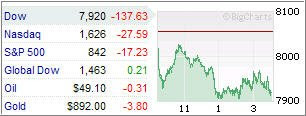 MarketWatch featured an article with the intriguing title “Rescue the economy? Try the SEALS.” Here are some highlights:
MarketWatch featured an article with the intriguing title “Rescue the economy? Try the SEALS.” Here are some highlights:
President Barack Obama has put the wrong federal agency in charge of the rescue of the financial system. Instead of hiring Tim Geithner and the TARP, he should have hired the U.S. Navy and the SEALs.
When lawless pirates captured an American sea captain, the Navy put the hostage first. Now he’s safe, and the hostage-takers are dead or jailed.
When lawless bankers captured the global economy, Geithner put the hostage-takers first. And the hostage-takers are stepping up their demands: Change the accounting rules, guarantee us against any losses from the toxic assets, and rig the stress test so we all come out smelling like roses.
Old-timers may remember with nostalgia the days when it was easy to tell the difference between a major financial institution and a criminal enterprise. Those days are long gone.
Consider, for instance, the indictment unveiled last week against a San Diego street gang on multiple counts of mortgage fraud. According to federal prosecutors, the gang arranged to buy 220 properties for more than $100 million from 2005 to 2008. They overpaid for the properties by taking out liar loans using phony appraisals. They then funneled a kickback to a company controlled by the defendants, the indictment says.
Liar loans? Phony appraisals? Kickbacks? That sounds pretty much like the business model for the mortgage brokerage industry in California during the bubble. Maybe the real complaint is that the mob was muscling in on their territory.
Or consider the report in Monday’s Wall Street Journal that the Troubled Asset Relief Program oversight panel is investigating complaints that the banks that received money from the TARP are raising interest rates and imposing new fees on customers.
It is indeed shocking to learn that banks are behaving like banks. Isn’t the whole point of the TARP to help the banks get back on their feet? And if they can’t sell trillions of dollars in credit default swaps to each other, the most profitable line of business they have left is the customer-gouging unit, also known as their credit-card businesses.
Citigroup defended a recent loan promotion that didn’t disclose that the annual interest rate was 30%. The interest rates “compare competitively to similar offers in the market,” a Citigroup spokesman told the Journal. So this is like an offer you can’t refuse? Liar loans, phony appraisals and kickbacks have been the mode of operation for the years leading up to the bursting of the real estate bubble. In order to really rescue the economy those, who led us into this mess, need to first be removed from their positions of power and replaced by management with competence and integrity. That’s one issue but to me, there is much more at stake. While there has been much talk about outright fraud and deception in the banking and mortgage industry, I have yet to see anyone being brought to justice. Quite the contrary; you only read about the very few who have been let go on good terms, and they are happily sailing into the sunset with their golden parachutes. This really concerns me, and I have asked myself on many occasions “has the American justice system failed?” What’s your view?
[My emphasis]






